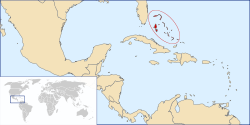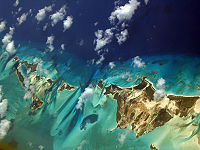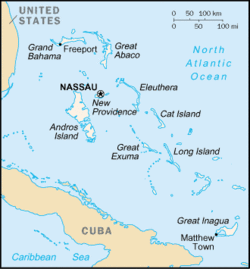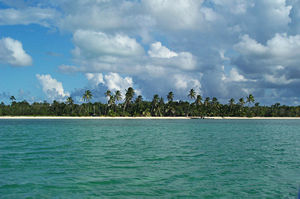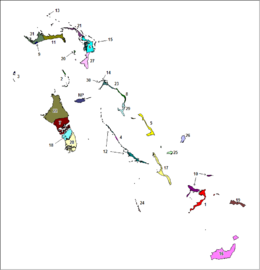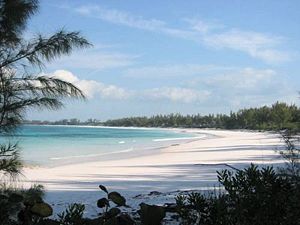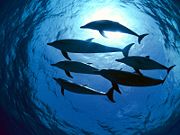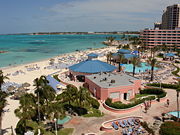The Bahamas
2008/9 Schools Wikipedia Selection. Related subjects: Americas; Countries
| The Bahamas The Commonwealth of The Bahamas
|
||||||
|---|---|---|---|---|---|---|
|
||||||
| Motto: "Forward, Upward, Onward Together" | ||||||
| Anthem: " March On, Bahamaland" Royal anthem: " God Save the Queen" |
||||||
|
|
||||||
| Capital | Nassau |
|||||
| Official languages | English | |||||
| Demonym | Bahamian | |||||
| Government | Parliamentary democracy and Constitutional monarchy | |||||
| - | Monarch | Queen Elizabeth II | ||||
| - | Governor-General | Arthur Dion Hanna | ||||
| - | Prime Minister | Hubert Ingraham | ||||
| Independence | from the United Kingdom | |||||
| - | Self-governing | 1964 | ||||
| - | Full independence | July 10, 1973 | ||||
| Area | ||||||
| - | Total | 13,878 km² ( 160th) 5,358 sq mi |
||||
| - | Water (%) | 28% | ||||
| Population | ||||||
| - | 2007 estimate | 330,549 ( 177th) | ||||
| - | 1990 census | 254,685 | ||||
| - | Density | 23.27/km² ( 181st) 60/sq mi |
||||
| GDP ( PPP) | 2005 estimate | |||||
| - | Total | $6.524 billion ( 145th) | ||||
| - | Per capita | $17,843 ( 38th) | ||||
| HDI (2007) | ▲ 0.845 (high) ( 49th) | |||||
| Currency | Dollar ( BSD) |
|||||
| Time zone | EST ( UTC−5) | |||||
| - | Summer ( DST) | EDT ( UTC−4) | ||||
| Internet TLD | .bs | |||||
| Calling code | +1 242 | |||||
The Commonwealth of the Bahamas is an independent, sovereign, English-speaking country consisting of two thousand cays and seven hundred islands that form an archipelago. It is located in the Atlantic Ocean southeast of the United States; north of Cuba, Hispaniola (Dominican Republic & Haiti) and the Caribbean Sea; and northwest of the Turks and Caicos Islands.
History
The seafaring Taino people moved into the uninhabited southern Bahamas from Hispaniola and Cuba around the 7th century AD. These people came to be known as the Lucayans. There were an estimated 30,000+ Lucayans at the time of Columbus' arrival in 1492.
Christopher Columbus's first landfall in the New World was on an island he named San Salvador (known to the Lucayans as Guanahani) which is generally accepted to be present-day San Salvador Island (also known as Watling Island) in the southeastern Bahamas. Here, Columbus made first contact with the Lucayans and exchanged goods with them.
The Spaniards who followed Columbus depopulated the islands and they were deserted until the arrival of the Eleutherian Adventurers from Bermuda in the mid 1600s. The Adventurers (who were English) established the first permanent European settlements on an island which they named Eleuthera - the name derives from the Greek word for freedom. They later discovered New Providence and named it Sayle's Island. To survive, the settlers looted passing ships.
In 1670 King Charles II granted the islands to the Lord Proprietors of the Carolinas, who rented the islands from the king with rights of trading, tax, appointing governors, and administering the country.
During proprietary rule, the Bahamas became a haven for pirates, including the infamous Blackbeard. To restore orderly government, the Bahamas was made a British crown colony in 1718 under the royal governorship of Woodes Rogers, who cracked down on piracy.
During the American Revolutionary War, the islands were a target for American naval forces under the command of Commodore Ezekial Hopkins. The capital of Nassau on the island of New Providence was occupied by US Marines for a fortnight.
In 1782, after the British defeat at Yorktown, a Spanish fleet appeared off Nassau, which surrendered without a fight. But the 1783 Treaty of Versailles - which ended the global conflict between Britain, France and Spain - returned the Bahamas to British sovereignty.
After the American Revolution, some 8,000 loyalists and black loyalists moved to the Bahamas from New York, Florida and the Carolinas. The Americans established plantations on several out islands and became a political force in the capital. The small population became mostly African from this point on.
The British abolished the slave trade in 1807, which led to the forced settlement on Bahamian islands of thousands of Africans liberated from slave ships by the Royal Navy. Slavery was finally abolished in the British Empire on August 1, 1834.
Modern political development began after the Second World War. The first political parties were formed in the 1950s and the British made the islands internally self-governing in 1964. In 1973, the Bahamas became fully independent, but retained membership in the Commonwealth of Nations.
In 1967, Lynden Pindling became the first black premier of the colony, and in 1968 the title was changed to prime minister. Another black Bahamian, Sir Milo Butler, was appointed governor-general upon independence.
Based on the twin pillars of tourism and offshore finance, the Bahamian economy has prospered since the 1950s. However, there remain significant challenges in areas such as education, health care, international narcotics trafficking and illegal immigration from Haiti.
The origin of the name "Bahamas" is unclear. It may derive from the Spanish baja mar, meaning "shallow seas"; or the Lucayan word for Grand Bahama Island, ba-ha-ma "large upper middle land".
Geography
The closest island to the United States is Bimini, which is also known as the gateway to the Bahamas. The island of Abaco is to the east of Grand Bahama. The southeasternmost island is Great Inagua. Other notable islands include the Bahamas' largest island, Andros Island, and Eleuthera, Cat Island, Long Island, San Salvador Island, Acklins, Crooked Island, Exuma and Mayaguana. Nassau, the Bahamas capital city, lies on the island of New Providence.
All the islands are low and flat, with ridges that usually rise no more than 15 to 20 m (49 to 66 ft). The highest point in the country is Mount Alvernia, or Como Hill, which has an altitude of 63 metres (210 ft). To the southeast, the Turks and Caicos Islands, and three more extensive submarine features called Mouchoir Bank, Silver Bank, and Navidad Bank, are geographically a continuation of the Bahamas, but not part of the Commonwealth of the Bahamas..
The climate of the Bahamas is subtropical to tropical, and is moderated significantly by the waters of the Gulf Stream, particularly in winter. Conversely, this often proves very dangerous in the summer and autumn, when hurricanes pass near or through the islands. Hurricane Andrew hit the northern islands during the 1992 Atlantic hurricane season, and Hurricane Floyd hit most of the islands during the 1999 Atlantic hurricane season. Hurricane Frances hit in 2004; the Atlantic hurricane season of 2004 was expected to be the worst ever for the islands. Also in 2004, the northern Bahamas were hit by a less potent Hurricane Jeanne. In 2005 the northern islands were once again struck, this time by Hurricane Wilma. In Grand Bahama, tidal surges and high winds destroyed homes and schools, floated graves and made roughly 1,000 people homeless, most of whom lived on the west coast of the island.
Districts
The districts of the Bahamas provide a system of local government everywhere in The Bahamas except New Providence, whose affairs are handled directly by the central government. The districts other than New Providence are:
|
|
|
Government and politics
The Bahamas is an independent country and a member of the Commonwealth of Nations. Political and legal traditions closely follow those of the United Kingdom.
Queen Elizabeth II is the Head of State, represented by a Bahamian governor-general. The prime minister is the head of government and is the leader of the party with the most seats in the elected House of Assembly. The current governor-general is Arthur Dion Hanna and the current prime minister is Hubert Alexander Ingraham. The upper house (the Senate) is appointed. Executive power is exercised by the cabinet. Legislative power is vested in the two chambers of parliament.
The party system is dominated by the centre-left Progressive Liberal Party and the centre-right Free National Movement. A handful of splinter parties have been unable to win election to parliament. These parties have included the Bahamas Democratic Movement, the Coalition for Democratic Reform and the Bahamian Nationalist Party.
Constitutional safeguards include freedom of speech, press, worship, movement, and association. Although The Bahamas is not geographically located in the Caribbean, it is a member of the Caribbean Community. The judiciary is independent of the executive and the legislature. Jurisprudence is based on English common law.
Demographics
Blacks 85%, Whites 12%, Asian and Hispanic 3% according to the last census completed about the races on the island, which was recorded in 1953.
| Region | European | % | Mixed | % | African | % | Total |
|---|---|---|---|---|---|---|---|
| New Providence | 6,758 | 14.80% | 6,804 | 14.90% | 32,108 | 70.30% | 45,670 |
| Andros and Berry Islands | 97 | 1.30% | 299 | 4.01% | 7,065 | 94.69% | 7,461 |
| Grand Bahama and Bimini | 450 | 8.30% | 721 | 13.31% | 4,248 | 78.39% | 5,419 |
| Abaco | 1,146 | 33.63% | 225 | 6.60% | 2,037 | 59.77% | 3,408 |
| Harbour Island | 861 | 56.42% | 53 | 3.47% | 612 | 40.10% | 1,526 |
| Eleuthera | 662 | 10.93% | 1,062 | 17.54% | 4,332 | 71.53% | 6,056 |
| Cat Island | 12 | 0.37% | 86 | 2.69% | 3,103 | 96.94% | 3,201 |
| Exuma | 59 | 2.02% | 61 | 2.09% | 2,799 | 95.89% | 2,919 |
| San Salvador and Rum Cay | 46 | 5.56% | 51 | 6.17% | 730 | 88.27% | 827 |
| Long Island and Ragged Island | 564 | 13.84% | 2,072 | 50.83% | 1,440 | 35.33% | 4,076 |
| Crooked Islands, Acklins and Long Cay | 7 | 0.32% | 513 | 23.44% | 1,669 | 76.24% | 2,189 |
| Mayaguana and Inagua | 60 | 3.74% | 95 | 5.93% | 1,448 | 90.33% | 1,603 |
| Bahamas | 10,722 | 12.71% | 12,042 | 14.28% | 61,591 | 73.01% | 84,355 |
Source:
Population: 300,529 (July 2002 est.) Age structure: 0-14 years: 29% (male 43,964; female 43,250) 15-64 years: 64.7% (male 95,508; female 98,859) 65 years and over: 6.3% (male 7,948; female 11,000) (2002 est.) Population growth rate: 0.86% (2002 est.) Birth rate: 18.69 births/1,000 population (2002 est.) Death rate: 7.49 deaths/1,000 population (2002 est.) Net migration rate: -2.63 migrant(s)/1,000 population (2002 est.) Sex ratio: at birth: 1.02 male(s)/female under 15 years: 1.02 male(s)/female 15-64 years: 0.97 male(s)/female 65 years and over: 0.72 male(s)/female total population: 0.96 male(s)/female (2002 est.) Infant mortality rate: 17.08 deaths/1,000 live births (2002 est.) Life expectancy at birth: total population: 69.87 years female: 73.49 years (2002 est.) male: 66.32 years Total fertility rate: 2.28 children born/woman (2002 est.) Nationality: noun: Bahamian(s) adjective: Bahamian Ethnic groups: black 85%, white 12%, Asian and Hispanic 3% Religions: Baptist 32%, Anglican 20%, Roman Catholic 19%, Methodist 6%, Church of God 6%, other Protestant 12%, none or unknown 3%, other 2% Languages: English, Creole (among Haitian immigrants) Literacy (age 15+): total population: 98.2% male: 98.5% female: 98% (1995 est.)
Source: The Bahamas guide
Culture
In the less developed outer islands, handicrafts include basketry made from palm fronds. This material, commonly called "straw", is plaited into hats and bags that are popular tourist items.
Regattas are important social events in many family island settlements. They usually feature one or more days of sailing by old-fashioned work boats, as well as an onshore festival.
Some settlements have festivals associated with the traditional crop or food of that area, such as the "Pineapple Fest" in Gregory Town, Eleuthera or the "Crab Fest" on Andros. Other significant traditions include story telling.
The islands are overwhelmingly Christian; the largest denominations being Baptist, Anglican and Roman Catholic. A few people, especially in the southern and eastern islands, practice Obeah, a spiritistic religion similar to Voodoo. Voodoo is also practiced by a large number of people in neighboring Haiti.
Sailing and Track and field athletics are popular sports in the country. Football and rugby also have strong followings while American sports such as basketball, softball, baseball and American football are gaining in popularity.
Bahamians have won Olympic gold medals in sailing (Sir Durwood Knowles and Cecile Cooke in 1964) and track and field ( Tonique Williams-Darling in the 400 m in 2004 and the women's relay team in the 4×100m in 2000). They are also very active in the world of karting; the current Bahamian champion is Genevieve Siddons.
Economy
The Bahamian dollar is pegged to the US dollar, and US notes and coins are used interchangeably with Bahamian currency for most practical purposes. However, government exchange controls still apply for the purchase of foreign currency.
The Bahamas is classified as an upper middle-income developing country and has the third highest per capita income in the western hemisphere (after the United States and Canada). Tourism is the primary economic activity, accounting for about two thirds of the gross domestic product (GDP). Offshore finance is the second largest industry, accounting for about 15 per cent of GDP.
The government continues to promote tourism and financial services while aiming for greater diversification through agriculture, fishing, manufacturing and e-commerce.
In the 1960s, the country enjoyed robust growth averaging 9 per cent annually as direct foreign investment spurred the development of tourism. A global economic downturn after the 1973 oil price shock coincided with Bahamian independence and led to a drop in foreign investment.
Toward the end of that decade economic performance improved, led by growth in tourism; and international narcotics trafficking. Real GDP growth in the 1980-84 period averaged 3 per cent, but declined in the late 1980s. GDP growth was 0.3 per cent in 1995 and accelerated to 6 per cent in 1999. After 9/11 the economy slumped temporarily due to travel fears, but began growing again in 2002.
Historically, most development has occurred on New Providence and Grand Bahama, causing significant migration from the Family Islands to these two urban centers and straining their infrastructure. The government is also faced with the burden of duplicating facilities and services throughout the archipelago.
There is no income, corporate or capital gains tax. Government revenues are derived from import tariffs, excise taxes, property taxes, business licenses and fees.


